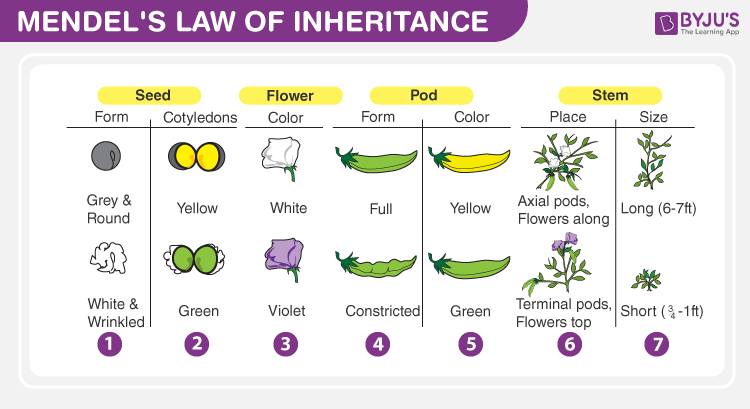Table of Contents
Introduction
Inheritance is the acquiring of genetic characteristics or traits from parents by their offspring. In humans, both parents equally contribute to the inheritance of traits. In 1860, Gregor Mendel studied the rules of inheritance of traits. He conducted an experiment on pea plants for the same. He cultivated pea plants and observed their pattern of inheritance from one generation to the next generation. This observation resulted in the discovery of three laws of inheritance, famously known as Mendel’s laws of Inheritance. Let us have a brief discussion on the contribution of Mendel in establishing the law of inheritance of traits.

Mendel’s Contribution to the Inheritance Law
Mendel is known as the father of genetics. Mendel’s laws are the Law of Dominance, Law of Segregation and Law of Independent Assortment. These laws came into existence from experiments on pea plants with a variety of traits.
In the first experiment, only a single character (plant height) was considered and was known as monohybrid inheritance. Another experiment was based on two characters (seed shape and colour), thus called dihybrid inheritance.
Monohybrid Inheritance
Mendel crossbred a pure tall plant and a pure short plant, which produced the first generation of pea plants. All the plants in the first generation were tall plants. He called this generation Filial 1 or F1 generation and the offspring were named F1 progeny. Then, he crossbred the tall plants of the F1 generation to produce the Filial 2 generation or the F2 generation. Mendel observed that the F2 generation had some short plants present whereas, the ratio of the tall plants to short plants in the F2 generation was roughly 3:1. He theorised that the short traits were present even within the F1 generation, but were not expressed due to the tall trait being dominant over the recessive short trait. These observations led to the formulation of the Law of Segregation and Law of Dominance.
Dihybrid Inheritance
Mendel took two contradicting traits together for crossing i.e. colour and shape of seeds. He chose a round yellow seed and a wrinkled green seed and crossed them. He obtained only round yellow seeds in the F1 generation. Then, F1 progeny was self-pollinated, which gave four different combinations of seeds i.e. round-yellow, wrinkled-yellow, round green and wrinkled green seeds in the F2 generation. Thus, Mendel concluded that the alleles of the shape trait do not affect the sorting of the colour trait among the gametes. This means that alleles of two different genes get independently assorted from one another into the gametes. Based on this observation, he developed his third law – the Law of Independent Assortment.
Check Dihybrid Cross and Inheritance of Two Genes to know more about this type of inheritance.
Later, based on the conclusions and observation of Mendel’s relation between traits and inheritance, factors (genes) responsible for heredity were discovered.
To know more about Mendel’s experiments and laws of inheritance, visit the links given above.
Important Terminologies:

Comments